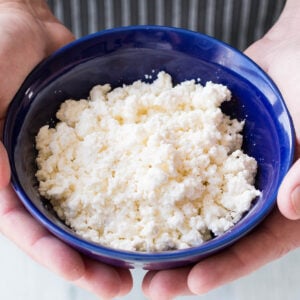Queso Fresco (Queso Blanco) is ideal for crumbling over so many hot dishes just before serving! This homemade recipe makes the best crumbly white cheese with milk and a coagulating agent like vinegar, lemon, or lime juice. Very easy and VERY fresh!

Queso Fresco Recipe (Queso Blanco)
Queso fresco, or “fresh cheese”, is a cheese widely used in Mexican dishes and South American cooking. It adds a touch of texture and freshness to a dish and, because it doesn’t melt like many Mexican cheeses, is ideal for crumbling over hot dishes just before serving. Instead of melting, it softens and becomes creamy without losing shape!
Most commercial queso fresco recipes are made using an enzyme called "rennet" to curdle the milk, but it's very easy to make at home using an acid like vinegar, lemon juice, or lime juice.
It's unaged and very mild with a slightly tangy flavor. Despite being made from milk, it is not rich but rather quite light, with salty-sour notes.
Queso Fresco is meant to be used right away in its crumbly form, perfect for spicy dishes, or it can be pressed with weights to form a cheese that can be fried. Also, yes, fried cheese is absolutely worth drooling over!
Ingredients Needed
- Milk - Whole milk is great for this. You can use heavy cream or low fat milk, though you'll get more flavor with more fat. The only milk you can’t use is milk labeled ultra-pasteurized.
- Acid - I use vinegar most of the time, though you can use fresh lemon or lime juice if preferred.
- Salt
How to Make Queso Fresco Cheese
Heat the milk. First, heat your milk slowly in a large pot. Don't heat too quickly or you risk scalding the milk, which will result in a burnt flavor. Bring the milk to about 185-190°F when measured with a thermometer. You do not want to bring it to a boil.
Add an acid. Turn off the heat and stir in your acid (vinegar, lemon juice or lime juice) a spoonful at a time. It doesn’t matter which acid you use as the coagulating agent, but lemon or lime juice will impart a bit of citrus flavor in the finished product, so plan accordingly. I prefer lime juice for most applications.
Stir and allow to separate. Stir continuously as you add your acid and watch for curdling to occur. It will be obvious as milk clumps, or “curds”, form and separate from the watery substance, or “whey”. It's difficult to know exactly how much acid you will need, so keep extra on hand and keep adding it a bit at a time in until curdling starts.

Let it sit. Once the curds form, stop and let the pot sit for about 20 to 30 minutes to complete the process.
Strain the curds from the whey. Next, set a lined colander with cheesecloth over a large bowl and strain the curds from the whey.

Recipe Tips & Notes
- Know when to use the cheese. The curds can be used immediately and will be lumpy but somewhat creamy. You can mix in a bit of salt and spread it over breads or crumble it over foods as described above. However, it is best to let it drain for 10-20 minutes for most uses.
- You can make it firmer. If you’d prefer drier, firmer cheese, wrap up the ends of the cheesecloth and continue to drain an hour or so. You can also place a weight over the top that will press the cheese for several hours, until it is packed and dense.
- Use the whey. You can discard the whey if you’d like, but I like to keep it for other uses. It is ideal for tenderizing meats or for use in starting the fermentation process for foods like pepper mash. Consider freezing it for future use.
Storage
Queso blanco will keep for about a week in the refrigerator, though it is best when used immediately. Be sure to keep it stored in an airtight container.

How Can I Use Queso Fresco?
- Queso fresco is most often used as a finisher for dishes. Simply crumble it over the top of tacos or salads, refried or black beans, pretty much anything served hot in a pan. Crumble it directly over a plate just before serving. It adds a pop of both texture and color.
- If using very fresh queso fresco that hasn’t drained much, mix it with salt and fresh herbs for a spreadable cheese.
- If you drain the queso cheese much longer you can also press the cheese, which makes is more compact, and you can grill it and either incorporate it into other dishes or enjoy it as a snack.
What Cheeses Are Similar to Queso Fresco?
Queso fresco is very similar to queso blanco in texture and flavor and not so creamy like goat cheese. The difference lies only in the curdling process.
It is also similar to feta cheese, which (like queso fresco) is made with rennet, but also brined and aged. Paneer, a staple cheese in Indian cuisine for thousands of years, is essentially the same thing as queso fresco. It is also known as “Farmers Cheese”.
What Type of Milk Should I Use to Make Queso Fresco?
The only milk you can’t use is milk labeled ultra-pasteurized, which will not curdle. Otherwise, you can use any type of milk from the store to make homemade queso blanco.
Original farmers cheese was made with raw cow milk, sheep or goat milk, with cow and goat milk being very popular, but today you’ll most likely need to grab milk from the store.
Crumble Fresh Queso Fresco Over these Popular Recipes
- Pork Chili with Roasted Red Hatch Peppers (great with a slow cooker or crock pot)
- Chilaquiles Rojos
- Black Bean Dip
- Lamb Vindaloo
- Menemen (Turish Style Scrambled Eggs - very delicious!)
- Huevos Rancheros
- Elotes (Mexican Street Corn)
Got any questions? Ask away! I’m happy to help. If you enjoy this recipe, I hope you’ll leave a comment with some STARS. Also, please share it on social media. Don’t forget to tag us at #ChiliPepperMadness. I’ll be sure to share! Thanks! — Mike H.

Queso Fresco Recipe (Queso Blanco)
Ingredients
- 1 gallon milk
- ¼ cup vinegar lemon juice or lime juice
- Salt to taste
Instructions
- Heat the milk slowly in a large pot to 185-190 degrees F.
- Turn off the heat and stir in your acid – vinegar, lemon juice or lime juice – a spoonful at a time, stirring, until curds form and separate from the yellowish whey. Let it sit for 10-20 minutes.
- Set a colander lined with cheesecloth over a bowl and strain the curds from the whey. Discard the whey or keep it for other uses.
- Add salt at this stage, if desired, and stir.
- Stir the curds up a bit and let it drain for 10-20 minutes.
- For firmer cheese, wrap up the ends of the cheesecloth and continue to drain an hour or so. For dense cheese, place a weight over the top of the wrapped cheese (or cheese that has been placed in a cheese mold) that will press it for several hours, until it is packed.
Video
Notes
Nutrition Information

NOTE: This recipe was updated on 10/12/25 to include new information and photos. It was originally published on 4/26/17.



Traci says
Pin this !
These are authentic Mexican recipes that taste like Veracruz kitchens, makes me a bit homesick, I lived there for a few years and learned secrets of the kitchen from my sister in law and great mother in law. Trying out Mike's queso fresco using lime, I make my own cheeses but have not sone ago yet with lime, can't wait! Love all of his recipes Time to spoil my family here in Melbourne.❤️❤️
Mike Hultquist says
Thanks so much, Traci! Glad to be helpful!